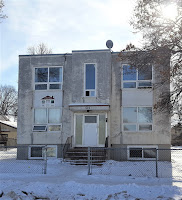© 2020, Christian Cassidy
This is part two of a post about the Cumberland Corridor created in 1970. For part one.
At first glance, the six-unit Ross Apartments at 610 Ross Avenue appears unremarkable. It is one of many hundred small residential blocks that dot the inner city. The story behind how it got to this site 50 years ago, however, was big news and a symbolic victory for community organizations in an era when thousands of people were being displaced from their homes for new urban developments.
May 15, 1971, Winnipeg Tribune
The group at the centre of the story is the People's Committee for a Better Neighbourhood Inc.. It operated from a small building at 155 Isabel Street and served what was known then as Roosevelt Park, or Urban Renewal Area 2, bounded by Sherbrook Street, William Avenue, Princess Street and Ross Avenue. It dealt with issues such as access to health care, food security and affordable housing in the neighbourhood.
The looming urban development that hung over the neighbourhood through the 1960s and 70s was the possible Sherbrook McGregor overpass that would replace the ageing Arlington and Salter Street overpasses. The roadways leading up to the structure would have cut a swath through the heart of the neighbourhood and require the demolition of a couple of hundred buildings and the displacement of over 1,000 people.
The University of Winnipeg's Institute of Urban Studies (IUS), headed by Lloyd Axworthy at the time, worked closely with the People's Committee. In April 1970, an IUS staff member forwarded to the group an ad taken out by Metro Winnipeg seeking tenders for the mass demolition of eighteen properties along the route of what would become the Cumberland Corridor. It was a reminder that a similar fate, but on a much larger scale, could face their neighbourhood.
May 4, 1970, Winnipeg Tribune
The People's Committee convinced Metro Winnipeg to postpone the demolitions so that they could see if any of the residential structures could be moved to a new location. After inspection, thirteen were deemed to be suitable and they chose two houses and a small apartment block. Vandals soon broke into the houses and caused extensive damage leaving them with just the six-unit Sherwell Apartments built in 1955 at 728 Sherbrook Street.
The city refused to donate a piece of land for the block to sit on and provincial government, which was responsible for housing, also did not offer any assistance. As the Citizens Committee scrambled to find a new home for the Sherwell, the roadworks project was well underway and an impatient Metro Winnipeg announced that the building would be demolished on Friday, June 26th.
Two days before the demolition deadline the Peoples' Committee organized a march that attracted about 50 people. It ended at the legislature where, in front of the media, they called upon Howard Pawley, then the minister responsible for public housing, to help save the building.
The next day, the province announced that it would provide a $48,000 low interest loan to the Peoples' Committee to offset the cost of the move and the construction of a new foundation. Metro ended up kicking in the $2,400 it would have cost to demolish the building.
It was happy news for the group. Stickers were made for store windows in Roosevelt Park that read "We got it - Peoples' Committee Moving Apartment". One of the first to put one up was George Myers of Myers Drugs, a member of the group.
The Sherwell, before and after the move
A lot was procured on Ross Avenue across from the mostly abandoned Midland Rail yard site, now the sports field behind the Freight House. The Sherwell was moved on the night of September 19, 1970 and sat while a new foundation, including two basement suites to replace the ones left behind on Sherbrook Street, were added. It also received new windows and other renovations.
On December 12, 1970, a grand opening of the newly rechristened Ross Apartments took place with 200 people in attendance. Guests included included Howard Pawley and Peoples' Committee chairwoman Wyn Noble. The group would be in charge of finding tenants and managing the building.
At the opening, Noble said that this should be the model for future expropriations - that good housing stock be moved rather than demolished. That, of course, wasn't the outcome, though the Peoples' Committee did renovate a number of derelict homes through the early 1970s.
The relocation of the apartment block was a symbolic victory showing that grassroots community groups could fight the city and have an impact on housing. Lloyd Axworthy summed up the building's importance in a May 15, 1971 interview with the Winnipeg Tribune:
"The apartment block was the first step. It effectively demonstrated the capacity of a neighbourhood group, supported by technical and professional services, to become responsible for the redevelopment of their own area".
To read more about the People's Committee for a Better Neighbourhood Inc. and the apartment block, see the IUS' archived copies of: A report on the 610 Ross project in the Roosevelt Park demonstration area (1971) and Process report of stage II : The People's Committee for a Better Neighbourhood Inc. (1971).

















No comments:
Post a Comment